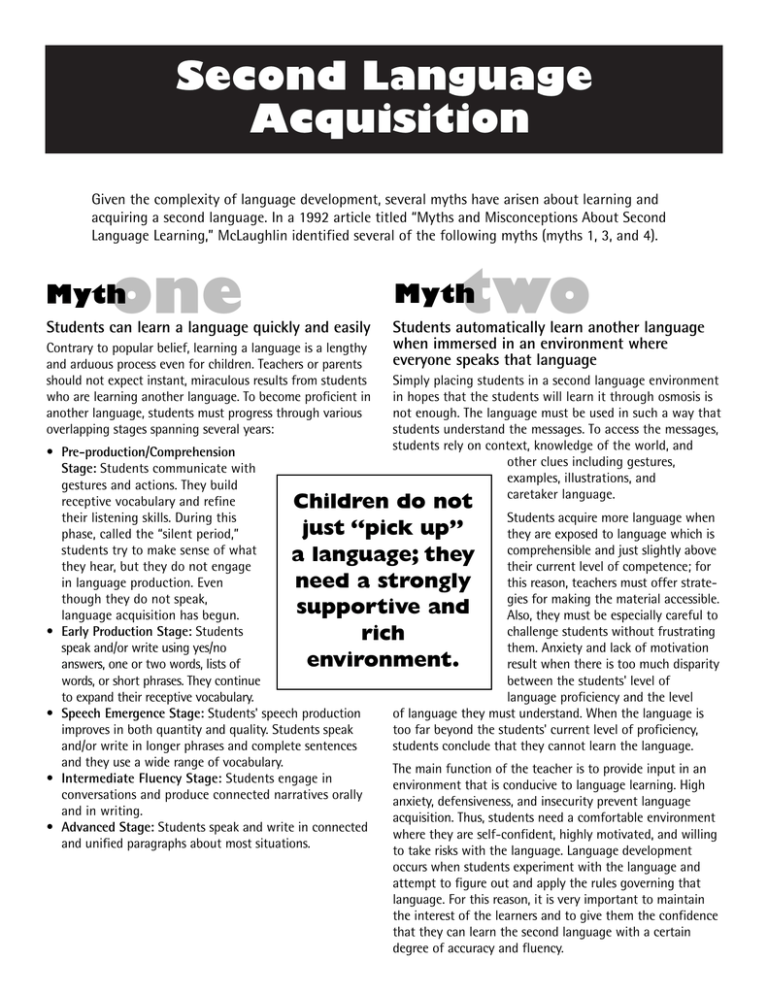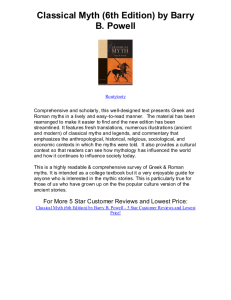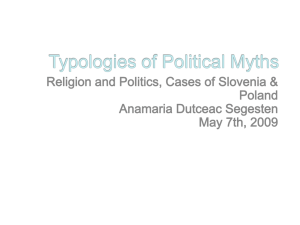Second Language Acquisition
advertisement

Second Language Acquisition Given the complexity of language development, several myths have arisen about learning and acquiring a second language. In a 1992 article titled “Myths and Misconceptions About Second Language Learning,” McLaughlin identified several of the following myths (myths 1, 3, and 4). one two Myth Myth Students can learn a language quickly and easily Students automatically learn another language when immersed in an environment where everyone speaks that language Contrary to popular belief, learning a language is a lengthy and arduous process even for children. Teachers or parents should not expect instant, miraculous results from students who are learning another language. To become proficient in another language, students must progress through various overlapping stages spanning several years: Simply placing students in a second language environment in hopes that the students will learn it through osmosis is not enough. The language must be used in such a way that students understand the messages. To access the messages, students rely on context, knowledge of the world, and other clues including gestures, examples, illustrations, and caretaker language. • Pre-production/Comprehension Stage: Students communicate with gestures and actions. They build receptive vocabulary and refine Children do not their listening skills. During this Students acquire more language when just “pick up” phase, called the “silent period,” they are exposed to language which is students try to make sense of what comprehensible and just slightly above a language; they they hear, but they do not engage their current level of competence; for in language production. Even this reason, teachers must offer strateneed a strongly though they do not speak, gies for making the material accessible. supportive and language acquisition has begun. Also, they must be especially careful to • Early Production Stage: Students challenge students without frustrating rich speak and/or write using yes/no them. Anxiety and lack of motivation environment. answers, one or two words, lists of result when there is too much disparity words, or short phrases. They continue between the students' level of to expand their receptive vocabulary. language proficiency and the level • Speech Emergence Stage: Students' speech production of language they must understand. When the language is improves in both quantity and quality. Students speak too far beyond the students' current level of proficiency, and/or write in longer phrases and complete sentences students conclude that they cannot learn the language. and they use a wide range of vocabulary. The main function of the teacher is to provide input in an • Intermediate Fluency Stage: Students engage in environment that is conducive to language learning. High conversations and produce connected narratives orally anxiety, defensiveness, and insecurity prevent language and in writing. acquisition. Thus, students need a comfortable environment • Advanced Stage: Students speak and write in connected where they are self-confident, highly motivated, and willing and unified paragraphs about most situations. to take risks with the language. Language development occurs when students experiment with the language and attempt to figure out and apply the rules governing that language. For this reason, it is very important to maintain the interest of the learners and to give them the confidence that they can learn the second language with a certain degree of accuracy and fluency. three five Myth Myth All students learn a second language in the same way Students need to learn grammar and vocabulary before they can speak As with first language acquisition, students follow the same process for language development, but they learn a second language at different rates and in different ways. This also applies to language minority students from different cultural backgrounds who may experience additional conflict in school because their ways of learning and communicating may be different from the ways of their American peers. Therefore, a good teacher will include a variety of instructional activities ranging from demonstrations, group and pair work, cooperative learning, peer tutoring, individualized instruction, and other strategies which take into account the variety of experiences and cultural backgrounds of second language learners. In and of themselves, the practices of learning words and breaking down and analyzing language components do not lead to language production nor do they lead to proficiency. While grammar and vocabulary are essential parts of language, they are only enablers which allow students to communicate. Students learn a second language more easily if they engage in meaningful activities requiring the use of the language and its components. For example, conjugating verbs is useless in itself, but correct verb forms become essential within the context of narrating one's daily activities. four Myth Students have acquired a second language once they can speak It is easy to assume that if students can converse comfortably in a second language, they can read and write the second language with equal ease. However, there is much more involved in learning a second language than learning how to speak it. While students may have developed the ability to communicate orally, their use of the language is often limited to social interactions. Similarly, heritage language learners may speak their home language only with family and peers. Thus, their vocabulary may have become restricted in some contexts while it may be extensive in others. Exposing both sets of students to a variety of audiences will help them broaden and vary their language. It is equally important to use caution in correcting students' errors. Systematic grammatical correction of errors does not improve the learners' language abilities. On the contrary it may hinder their motivation to use the language by placing emphasis on the form rather than the message. More effective feedback includes rephrasing and expanding on what the students have expressed. Resources Curtain, Helena and Carol Ann Bjornstad Pesola. 1994. Languages and Children: Making the Match. Longman Publishing Group. Krashen, Stephen. 1988. Second Language Acquisition and Second Language Learning. Prentice-Hall International. McLaughlin, Barry. 1992. “Myths and Misconceptions About Second Language Learning: What Every Teacher Needs to Unlearn” from Educational Practice Report: 5. National Center for Research on Cultural Diversity and Second Language Learning. Additionally, some students may be functionally illiterate in their first language. This is especially true of heritage language learners who may have learned the language at home, but who have been schooled in the US. It is also true of immigrant students who may not have received any formal schooling in their native (home) country. For additional information, contact: Fran Hoch, 919.807.3864 or fhoch@dpi.state.nc.us Bernadette Morris, 919.807.3865 or bmorris@dpi.state.nc.us Department of Public Instruction 301 N. Wilmington Street Raleigh, NC 27601-2825








